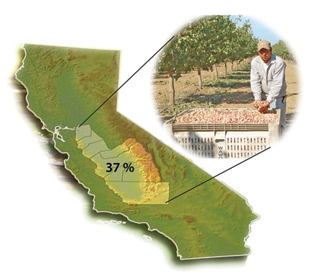California Agricultural Technology Institute
Ag economic output outlined
Recent CAB report reveals details of farming output in state, San Joaquin Valley
If you live in the San Joaquin Valley and you think agriculture is our region s most powerful economic engine, you re right.

According to newly-updated statistics on California economic output and employment, agriculture and its related industries in the San Joaquin Valley can boast of providing more than one third of all jobs in the region and nearly the same amount of dollar value in terms of goods and services produced.
The figures are provided in a recently-released report entitled, California Agriculture s Role in the Economy, and Water Use Characteristics, authored by Mechel Paggi, Ph.D., economist and director of Fresno State s Center for Agricultural Business (CAB).
The report outlines California agriculture s contribution to the state economy as a whole and also focuses on the San Joaquin Valley region, which includes Fresno, Kern, Kings, Madera, Merced, San Joaquin, Stanislaus and Tulare counties.
Agriculture creates significant multiplier effect throughout California s economy, Paggi said in outlining methodology for compiling the report. Every dollar gained in agriculture stimulates additional activity in the form of labor income, job creation and value added.
For example, a crop of processing tomatoes requires labor and machinery for soil preparation and planting, a fertilizer and pest control industry to enhance plant growth, an irrigation industry for water, more labor and machinery for harvest, a trucking industry to move the product, a processing industry for canning and packaging, and marketing and financial support to sell and deliver the final product.
So producing a crop not only provides income for a grower, but for a host of related businesses and services. Paggi s research team compiled and analyzed data from a number of sources and used special software programs to determine the multiplier, or ripple effects of agricultural production in both California and the valley.
In relation to all of California, data showed that the San Joaquin Valley accounted for more than 37 percent of the value of agricultural production and processing. Statewide, agriculture production and processing provided nearly 600,000 jobs, Paggi said. Including all related (indirect and induced activity) effects, the farming industry provided for more that 1.3 million jobs.
Another section of the agriculture report details supply and use of the most important commodity agriculture relies on water.
Such robust agricultural production in California has been made possible by irrigation supplied by a vast and integrated water infrastructure, Paggi notes. The U.S. Department of Agriculture estimated irrigated acreage in California for 2008 was 7.3 million acres, with an estimated 22.6 million acre feet of water applied.
Current challenges related to water use efficiency have prompted debate over the cultivation of certain high-water-use crops such as cotton and alfalfa, Paggi noted.
In this respect it is sometimes suggested that shifting production away from water intensive crops to ones that use less water is an obvious solution and win-win alternative to the status quo, he said. However, the complex relationship of supply and demand for all crops does not lend itself to an easy formulaic solution such as simply reducing or expanding production of selected crops.
To evaluate the potential returns for the economy from changes in water use patterns, water use needs to be considered in the context of other factors, including production, cross commodity linkages, and domestic and global market characteristics, Paggi said.
Complete details on the economics of agricultural production and water use may be found in the complete report, located on the CAB website at www.csufcab.com. For more information on CAB economics research, contact Paggi at mpaggi@csufresno.edu.
Back